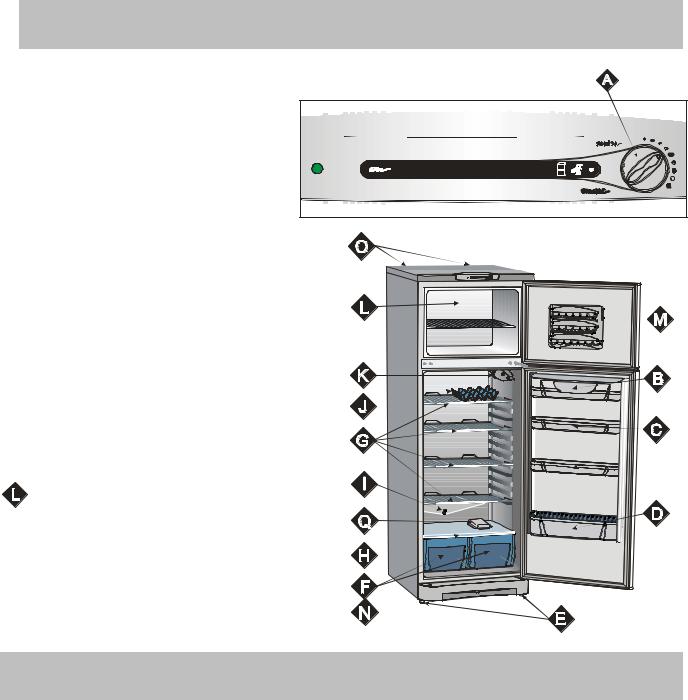Indesit RA 32 G User Manual [ru]

RA 32 G
Two-doors refrigerator-freezer
Installation and use
Двухдверный холодильник-морозильник Установка и использование

GB Two-doors refrigerator-freezer
Instructions for installation and use……………………………………… 3
CIS Двухдверный холодильник-морозильник
Инструкции по установке и использованию……………………………9
To maintain the EFFICIENCY and SAFETY of this appliance, we recommend:
-call only the Service Centers authorized by the manufacturer
-always use original Spare Parts
Производитель оставляет за собой право без предупреждения вносить изменения в конструкцию, не ухудшающие эффективность работы оборудования.
-Некоторые параметры, приведенные в этой инструкции, являются ориентировочными:
-Производитель не несет ответственности за незначительные отклонения от указанных величин.
2

Safety - a good habit to get into.
ATTENTION
Read your manual carefully since it contains instructions, which will ensure safe installation, use and maintenance of your appliance.
Your Refrigerator is built to International safety standards (EN60) and has been awarded the European approval mark (IMQ) for conformity with UK electrical safety requirements. It also meets the EC standards on the prevention and elimination of readio interference (EC directive 87/308 - 02.06.89).
1. This appliance is designed to be used indoors and under no circumstances should it be installed outside even if protected by a roof. Leaving the appliance exposed to the rain and whether is exceedingly dangerous.
2.The appliance should be used only by adults and exclusively for storing foodstuffs in compliance with the instructions provided in this manual. Under no circumstances should children be allowed to operate, or tamper with, this product.
3.Do not attempt to operate or handle this appliance when barefoot, or with wet hands or feet.
4.It is highly recommended that you do not operate this appliance by connecting it to the power supply with extensions or multiple socket plugs. If the refrigerator has been installed between two cabinets, make sure that the supply cord is not dangerously crimped or trapped beneath a heavy
object.
5.Never pull the cable or the appliance to remove the plug from the socket; this is exceedingly dangerous.
6.Do not touch the internal cooling elements, especially if your hands are wet, since you could burn or hurt yourself.
7.Before doing any cleaning, disconnect the appliance from the electricity (by pulling out the plug or turning off the general switch in your home); it is not sufficient to place the temperature regulation knob “off” to cut off the power.
8.Before disposing of your old appliance, remember to break or remove the lock as a safety measure to protect children who might lock themselves inside the appliance when playing. In addition, if the appliance is a new one with a lock, keep the key out of the reach of small children.
9.If your appliance is not operating properly, read the chapter entitled, “Trouble Shooting”, which might help you to resolve the problem, before calling an after-sales service center. Do not attempt to repair the appliance by tampering with the internal components.
10.If the power supply cord must be replaced, please contact one of our Customer Service Centers. In some cases, the connections are made using special terminals and in others a special tool must be used to access the connections.
11.Do not use electric appliances inside the compartment for food storage, if these are not those recommended by the manufacturer.
12.At the end of the functional life of your appliance – containing cyclopentane gas in the insulation foam and
gas R134a (tetraphtorethane) in the refrigeration circuit – the latter should made safe before being sent to the dump. For this operation, please contact your dealer or the Local Organisation in charge of waste disposal.
Installation
Proper installation of the appliance is essential to ensure the best and most efficient performance of your appliance.
Ventilation
The compressor and condenser generate heat and, therefore, need to be ventilated properly. Rooms with less than perfect ventilation are not very suited for installation of the appliance. Therefore, it should be installed in a room with
an opening (window or French window) that provides the appropriate amount of air re-circulation. It is also important that the room should not be too humid.
During installation, make sure not to cover or obstruct the grates that allow proper ventilation of the appliance. For proper ventilation of the appliance, you must leave:
-a space of at least 10 cm between the top part and any cabinets above it;
-a space of at least 5 cm between the sides of the appliance and any adjacent cabinets/walls.
Away from Heat
Avoid positioning the appliance in a place where it is
directly exposed to sunlight or near an oven, cook top or the like.
Levelling
The floor should be perfectly levelled; if not, you can adjust the feet at the front of the appliance.
Earthing
Before making the electrical connection, check that the voltage shown on the data plate, that you will find on the bottom left hand side of the appliance next to the crisper, corresponds to that of your mains and that the socket is earthed in conformity with all current electrical regulations. If the system is not earthed, the manufacturer declines all liability for consequent damages or losses. Do not use adapters or multiple sockets.
Check the power load
The electrical socket must support the maximum power load of the appliance shown on the data plate (on the bottom left hand side of the appliance next to the crisper).
Before plugging the appliance to the mains
Set the appliance upright and wait at least 3 hours before plugging the appliance into the mains to ensure proper performance.
3

A closer look
Fig. 1
 Thermostat knob for regulating the temperature
Thermostat knob for regulating the temperature
Use this knob to regulate the temperature of the refrig- 




 erator. The following settings are available:
erator. The following settings are available: 











 off - The refrigerator is off;
off - The refrigerator is off; 

 min - less cold;
min - less cold; 



 max - colder
max - colder 


 Hanging rack with transparent cover
Hanging rack with transparent cover
 Middle hanging rack
Middle hanging rack
 Lower hanging rack with bottles holder
Lower hanging rack with bottles holder
 Adjustable feet
Adjustable feet
 Fruit and vegetable drawer
Fruit and vegetable drawer
 Removable height adjustable shelves
Removable height adjustable shelves
 Glass tray
Glass tray
 Drainage system for thawn water
Drainage system for thawn water
 Eggs tray
Eggs tray
 Lamp
Lamp
Compartment for freezing and frozen food
storage  Ice container
Ice container
 Ice scraper
Ice scraper
 Rear stoppers (Fig. 4)
Rear stoppers (Fig. 4)  Butter dish with cover
Butter dish with cover
Setting up Your Appliance
NOTICE
After the appliance has been delivered, stand it in the upright position and wait approximately 3 hours before connecting it to the electrical outlet to guarantee that it operates properly.
Before placing foodstuffs in the refrigerator or freezer, clean the interior well with warm water and baking soda.
After putting the plug in the socket, make sure that the light is on inside the appliance and then turn the thermostat knob (A) to the “medium” setting. After a few hours have passed, you can place fresh food in the refrigerator compartment and frozen foods into the freezer.
4

How to use the refrigerator compartment...
The thermostat automatically regulates the temperature inside the appliance
min - less cold max - colder
It is recommended that a medium setting be used.
To increase the amount of space, optimize arrangement and improve appearance, this appliance has a “cooling area” located within the back panel of the refrigerator compart-ment. When the appliance is operating, this panel may be covered with frost or droplets of water depending on whether the compressor is operating or not at a given
time. Do not be concerned about this! The refrigerator is operating normally.
If the thermostat knob is positioned on higher settings while the refrigerator is heavily filled and the ambient temperature is high, the appliance may run continuously, resulting in the formation of frost on the back cooling area. This will lead to an increase in energy consumption.
To avoid this situation, just turn the thermostat knob
to a lower setting so that the appliance defrosts automatically.
Storing food in the Refrigerator Compartment
Food |
Storage time |
Location in the Refrigerator |
|
|
|
Wrapped meat and cleavec fish |
|
On the shelf above the vegetable crisper |
(use plastic wrap or pack in plastic bags) |
2 or 3 days |
(which is the coldest area). |
Fresh cheese |
|
On the shelf above the vegetable crisper |
|
3 or 4 days |
(which is the coldest area). |
Eggs |
1 month |
In special egg tray on any shelf |
Butter, margarine |
1 week |
On any shelf |
Cooked or precooked food (placer in air-tight containers |
3 or 4 days |
On any shelf |
and when cool store in refrigerator) |
|
|
Sausages, salami, sandwich meats in general, fresh pasta, |
3 or 4 days |
On any shelf |
custards, puddings, chocolates, cream pastries, bread, dry |
|
|
pastries, red tomatoes |
|
|
Bottled products, milk, drinks, yoghurt |
3 or 4 days |
On special door shelves |
Fruits and vegetables |
|
In vegetable crisper |
What Should Not be Stored in the Refrigerator
Garlic (transmits odour), onions and leeks.
Bananas (they will turn black).
Citrus fruits.
Potatoes and root vegetables (store in dark, dry places).
-Within the refrigerator compartment, the air circulates naturally, with the colder air falling because it is heavier. This is the reason why meat and cheeses should be placed above the vegetable crisper.
-Please follow our instructions carefully on maximum storage time: any food, even the freshest, will not remain edible for any extended amount of time.
-Do not place liquids in containers without covering them because this will lead to an increase in the level of moisture within the refrigerator, causing the formation of frost.
-Remember to cool hot food before storing otherwise the temperature inside the appliance will increase, causing the
compressor to work harder and use more energy.
-Contrary to popular belief, cooked foods are not stored any longer than raw food.
-The refrigerator compartment is equipped with convenient, removable shelves which can be adjusted for height using the shelf guides. This allows you to place even large containers and foodstuffs in the refrigerator.
-Be careful not to place containers (plastic or glass), food or other objects in direct contact with the cooling area of the back wall of the refrigerator. This could harm the food, increase energy consumption and facilitate the formation of condensate (on food, containers, etc.).
Freezing Foods Properly
-For the preparation of food to be frozen, please consult
a specialized manual.
-Food that has be thawed, even partially, must not be re-
- Do not open the freezer door in the event of a power failure or malfunction. This precaution will slow the rise in temperature within the compartment. If the door is not opened, frozen and fast-frozen foods will remain in their
5

frozen: you must cook it in order to consume it (within 24 hours) or to freeze it once again.
-Fresh foods that you intend to freeze must not be placed in contact with those that are already frozen or those that have been fast-frozen. Rather, they must be placed on atop the grate in the freezer compartment, in contact with the walls of the compartment (back or side) if possible. Please keep in mind that proper conservation of frozen foods depends on the speed
with which they are frozen.
-During the freezing process, avoid opening the door of the freezer.
-The maximum daily quantity of food that can be frozen is indicated on the rating plate located to the left of the vegetable crisper.
-In order to freeze and then thaw foods optimally, it is recommended that you divide food into small portions so that they freeze quickly and uniformly. The packages should be clearly marked with the content and the date they were frozen.
-Do not open the freezer door in the event of a power failure or malfunction. This precaution will slow the rise in temperature within the compartment. If the door is not opened, frozen and fast-frozen foods will remain in their
current state for approximately 17 hours.
- Do not place full bottles in the freezer: they could easily burst because all liquids increase in volume when they freeze.
-If the ambient temperature remains below 14°C for an extended period of time, the temperature needed for extended storage of food in the freezer will not be reached, resulting in reduced storage life of the food.
-Fill the ice container so that they are no more indication of line.
Tips on Saving Energy
- Install the Appliance Properly
In other words, away from sources of heat and direct sunlight, in a well ventilated room complying with the minimum distances indicated in the paragraph entitled, “ Installation/ Ventilation.”
- Use the Right Temperature Setting
A setting which is too cold increases energy consumption.
- Do not Overfill
To conserve food properly, the cold air must circulate freely within the refrigerator. If it is overfilled, this will prevent proper air circulation, forcing the compressor to work continuously.
- Close the Doors
Open your refrigerator as little as possible because each time you do so you loose much of the cold air. To raise the tem-perature to the proper level again, the motor must work for a long time, consuming energy.
- Keep an Eye on the Seals
Keep the seals clean and make sure that they adhere well to the door. This alone will ensure that no cold air escapes
- No Hot Foods
A hot pot or pan placed in the refrigerator immediately raises the temperature by several degrees. Let hot cookware and food cool to ambient temperature before placing them in the re-frigerator.
- Defrost the Freezer
Check the thickness of the frost on the walls of the freezer and immediately defrost it if the layer of frost is too thick. (see the section entitled, “Keeping your Appliance in Shape”).
Keeping Your Appliance in Shape
Defrosting
WARNING: do not damage the refrigeration circuit. Do not use mechanical devices or other tools to speed up the defrosting process, unless they have been recommended by the manufacturer.
How to Defrost the Refrigerator
This appliance defrosts automatically and the water is channeled to the back toward the drain installed for this
Cleaning and maintenance
Always unplug the appliance from the mains before cleaning.
-Your appliance is manufactured with hygienic odourless materials. To preserve these characteristics, always use sealed containers for strong smelling foods to avoid the
-Dishwashable: All the removable parts can be cleaned by soaking in hot soapy water or detergent. If you own a
6
